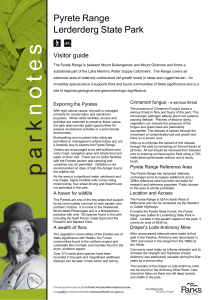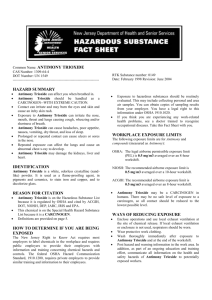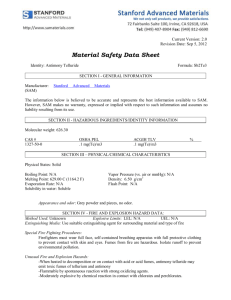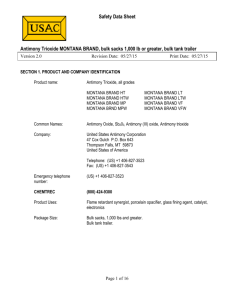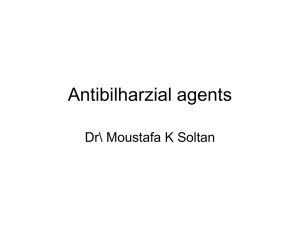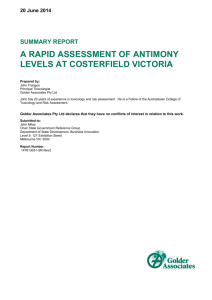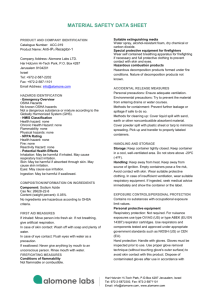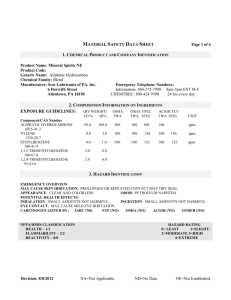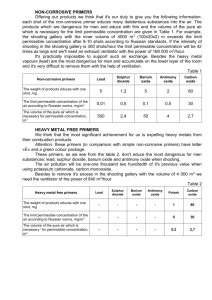printer friendly - United States Antimony Corporation
advertisement
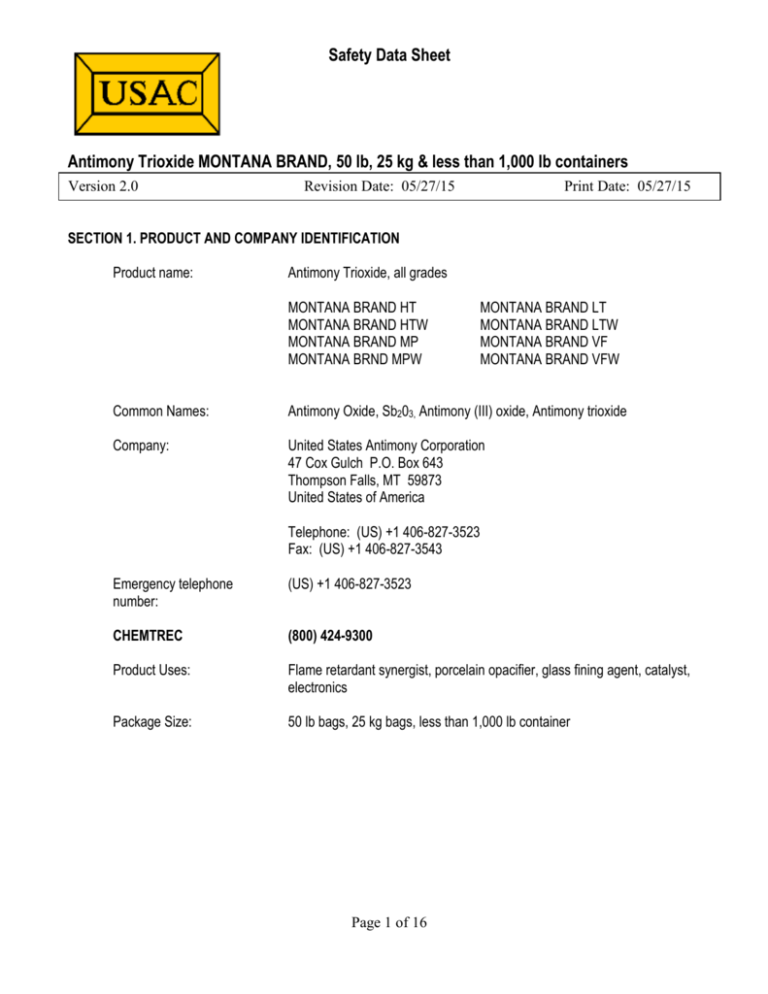
Safety Data Sheet Antimony Trioxide MONTANA BRAND, 50 lb, 25 kg & less than 1,000 lb containers Version 2.0 Revision Date: 05/27/15 Print Date: 05/27/15 SECTION 1. PRODUCT AND COMPANY IDENTIFICATION Product name: Antimony Trioxide, all grades MONTANA BRAND HT MONTANA BRAND HTW MONTANA BRAND MP MONTANA BRND MPW MONTANA BRAND LT MONTANA BRAND LTW MONTANA BRAND VF MONTANA BRAND VFW Common Names: Antimony Oxide, Sb203, Antimony (III) oxide, Antimony trioxide Company: United States Antimony Corporation 47 Cox Gulch P.O. Box 643 Thompson Falls, MT 59873 United States of America Telephone: (US) +1 406-827-3523 Fax: (US) +1 406-827-3543 Emergency telephone number: (US) +1 406-827-3523 CHEMTREC (800) 424-9300 Product Uses: Flame retardant synergist, porcelain opacifier, glass fining agent, catalyst, electronics Package Size: 50 lb bags, 25 kg bags, less than 1,000 lb container Page 1 of 16 Safety Data Sheet Antimony Trioxide MONTANA BRAND, 50 lb, 25 kg & less than 1,000 lb containers Version 2.0 Revision Date: 05/27/15 Print Date: 05/27/15 SECTION 2. HAZARDS IDENTIFICATION Emergency Overview OSHA Hazards Limited evidence of a carcinogenic effect. Target Organs Lungs GHS Classification Eye irritation (Category 2B) Skin irritation (Category ) Respiratory irritation (Category ) Harmful if swallowed (Category ) Carcinogenicity (Category 2) Acute aquatic toxicity (Category 3) GHS Label elements, including precautionary statements Pictogram Signal word Warning Hazard statement(s) H315 + H320 H H351 H402 Causes skin and eye irritation. Harmful if swallowed Suspected of causing cancer. Harmful to aquatic life. Precautionary statement(s) P281 P 306 + P351 + P338 Use personal protective equipment as required. IF IN EYES: Rinse cautiously with water for several minutes. Remove contact lenses, if present and easy to do so. Continue rinsing. Page 2 of 16 Safety Data Sheet Antimony Trioxide MONTANA BRAND, 50 lb, 25 kg & less than 1,000 lb containers Version 2.0 Revision Date: 05/27/15 P280 P284 Print Date: 05/27/15 Wear protective gloves/protective clothing Wear respiratory protection HMIS Classification Health Hazard: Chronic Health Hazard: Flammabiltiy: Physical Hazards: 2 * 0 0 NFPA Rating Health Hazard: Fire: Reactivity Hazard 2 0 0 Potential Health Effects Inhalation: Skin: Eyes: Ingestion: May cause respiratory tract irritation. May cause skin irritation. May cause eye irritation. May be harmful if swallowed. SECTION 3. COMPOSITION/INFORMATION ON INGREDIENTS Chemical Family Chemical Name Antimony oxide Arsenic Lead Non-ferrous metal oxide Formula Sb2O3 As Pb Molecular Wt. 291.52 g/mol 74.92 g/mol 207.2 g/mol Synonyms (common names) are provided in Section 1 Page 3 of 16 CAS No. 1309-64-4 13510-46-8 1317-36-8 Weight % >=99’7 <0.1% (as As) <0.1 (as Pb) Safety Data Sheet Antimony Trioxide MONTANA BRAND, 50 lb, 25 kg & less than 1,000 lb containers Version 2.0 Revision Date: 05/27/15 Print Date: 05/27/15 SECTION 4. FIRST AID MEASURES General advice Move out of dangerous area. Consult a physician. Show this Safety Data Sheet to the doctor in attendance. If inhaled If breathed in, move person to fresh air. If not breathing, give artificial respiration. Consult a physician. In case of skin contact Wash off with soap with plenty of water for at least 15 minutes. Consult a physician. In case of eye contact Rinse thoroughly with plenty of water for at least 15 minutes. Consult a physician. If swallowed Never give anything by mouth to an unconscious person. Rinse mouth with water. Consult a physician. SECTION 5. FIREFIGHTING MEASURES Conditions of flammability Not flammable or combustible. Suitable extinguishing media Use extinguishing agent suitable for type of surrounding fire. Hazardous combustion products Fumes of antimony oxide, arsenic oxide, and lead oxide Special protective equipment for firefighters Wear self-contained breathing apparatus, pressure demand, MSHA/NIOSH approved or equivalent, and full protective gear. Explosion Data Sensitivity to Mechanical Impact Sensitivity to Static Discharge Not sensitive Not sensitive Page 4 of 16 Safety Data Sheet Antimony Trioxide MONTANA BRAND, 50 lb, 25 kg & less than 1,000 lb containers Version 2.0 Revision Date: 05/27/15 Print Date: 05/27/15 SECTION 6. ACCIDENTAL RELEASE MEASURES Personal precautions Use personal protective equipment. Avoid dust formation. Avoid breathing dust, vapors, mist or gas. Ensure adequate ventilation. Evacuate personnel to safe areas. Environmental precautions Prevent further leakage or spillage if safe to do so. Do not let product enter drains. Discharge to the environment must be avoided. Methods and materials for containment and cleaning up Prevent large quantities of this product from contacting vegetation or waterways. Cover with plastic sheet to prevent spreading. Vacuum up, or sweep and shovel up without creating dust and transfer to properly labeled containers. Keep in suitable closed containers for disposal according to Federal, State and local laws. SECTION 7. HANDLING AND STORAGE Precautions for safe handling Avoid contact with skin and eyes. Avoid formation of dust and aerosols. Provide appropriate exhaust ventilation at places where dust is formed. Conditions for safe storage Keep in tightly closed, properly labeled containers in a dry and well-ventilated place. Page 5 of 16 Safety Data Sheet Antimony Trioxide MONTANA BRAND, 50 lb, 25 kg & less than 1,000 lb containers Version 2.0 Revision Date: 05/27/15 Print Date: 05/27/15 SECTION 8. EXPOSURE CONTROLS/PERSONAL PROTECTION Components with workplace control parameters Components CAS-No. Value Remarks Control Parameters Suspected human carcinogen Antimony trioxide 1309-64-4 Basis USA. Occupational Exposure Limits (OSHA) – Table Z-1 Limits for Air Contaminants TWA 0.5 mg/m3 USA. OSHA – Table Z-1 Limits for Air Contaminants – 1910.1000 Pneumoconiosis, Lung cancer. Exposure by all routes should be carefully controlled to levels as low as possible. Suspected human carcinogen TWA 0.5 mg/m3 USA. Occupational Exposure Limits (OSHA) – Table Z-1 Limits for Air Contaminants TWA 0.5 mg/m3 USA. OSHA – Table Z-1 Limits for Air Contaminants – 1910.1000 TWA 0.5 mg/m3 USA. NIOSH Recommended Exposure Limits TWA 0.5 mg/m3 Personal protective equipment Respiratory protection Where risk assessment shows air-purifying respirators are appropriate wear a NIOSH/MSHA (US) or CEN (EU) approved dust respirator fitted with type N100 (US) or type P3 (EN 143) (EU) dust cartridges as a backup to engineering controls. A respiratory protection program that meets OSHA 1910.134 and ANSI Z88.2 requirements must be followed whenever workplace conditions warrant a respirator’s use. Hand protection Chemical resistant protective gloves Eye protection Safety glasses with side-shields conforming to EN 166. Use equipment for eye protection tested and approved under appropriate government standards such as NIOSH (US) or EN 166 (EU). Skin and body protection Impervious clothing. The type of protective equipment must be selected according to the concentration and amount of the dangerous substance at the specific workplace. Hygiene measures Handle in accordance with good industrial hygiene and safety practice. Page 6 of 16 Safety Data Sheet Antimony Trioxide MONTANA BRAND, 50 lb, 25 kg & less than 1,000 lb containers Version 2.0 Revision Date: 05/27/15 Print Date: 05/27/15 Wash hands thoroughly before breaks and at the end of the day. Contaminated clothing should not be allowed out of the workplace. Wash contaminated clothing before reuse. Keep work areas clean. Do not eat, drink, chew gum, use tobacco products, or apply cosmetics in work areas. SECTION 9. PHYSICAL AND CHEMICAL PROPERTIES Appearance Form Color Odor Odor threshold Safety data pH Melting/freezing point Boiling point Flash point Evaporation rate Flammability Flammability Limit in Air Upper Flammability Limit Lower Flammability Limit Vapor pressure Vapor density Bulk density Specific gravity Water solubility Solubility in other solvents Partition coefficient Auto ignition temperature Decomposition temperature Viscosity, kinematic Viscosity, dynamic Explosive properties Oxidizing properties Molecular weight Kst Powder White Odorless not applicable not applicable 655°C (1,211°F) 1,425°C (2,594°F) not applicable not applicable non-combustible non-combustible non-combustible none at normal conditions no information available ≈60 lbs.ft3 5.67 g/cm3 370±37 µg/L no information available not applicable not applicable does not decompose not applicable not applicable non-explosive non-oxidizing 291.52 g/mol St 0 (0 bar m/s) Page 7 of 16 Safety Data Sheet Antimony Trioxide MONTANA BRAND, 50 lb, 25 kg & less than 1,000 lb containers Version 2.0 Revision Date: 05/27/15 Print Date: 05/27/15 SECTION 10. STABILITY AND REACTIVITY Reactivity None under normal use conditions Chemical stability Stable under normal conditions Possibility of hazardous reactions Reaction with strong reducing agents can produce toxic and flammable stibine gas. Conditions to avoid Strong acids Strong bases Strong oxidizing agents Strong reducing agents Hot perchloric acid Incompatible materials Strong reducing agents Strong oxidizing agents Hazardous decomposition products Hazardous decomposition products formed under fire conditions: Fumes of antimony oxide, arsenic oxide and lead oxide SECTION 11. TOXICOLOGICAL INFORMATION Acute toxicity Oral LD50 LD50 Oral – rat >34,600 mg/kg Inhalation LC50 No data available Dermal LD50 LD50 Dermal – rabbit >2,000 mg/kg Other information on acute toxicity LD50 Intraperitoneal – rat 3,250 mg/kg LD50 Intraperitoneal – mouse 172 mg/kg Skin corrosion/irritation May irritate skin May cause temporary small itchy pustules (antimony measles) in hot and humid conditions. Serious eye damage/irritation May irritate eyes; Eyes – rabbit – Mild eye irritation – Draize Test Page 8 of 16 Safety Data Sheet Antimony Trioxide MONTANA BRAND, 50 lb, 25 kg & less than 1,000 lb containers Version 2.0 Revision Date: 05/27/15 Print Date: 05/27/15 Respiratory or skin sensitizer Not a respiratory nor skin sensitizer. (IAOIA Risk Assesment 2004 – 2005) Information on toxicological effects Symtoms No information available Delayed and immediate effects as well as chronic effects from short and long-term exposure Acute effects Chronic toxicity Gastro-intestinal distress Prolonged and excessive inhalation exposures to antimony trioxide may result in respiratory effects, antimony pneumoconiosis, pulmonary fibrosis, inflammation of the lungs, airway obstruction, broncospasms, reproductive effects, gastrointestinal upset, liver effects, and neurological effects (muscle weakness, subnormal gait). Prolonged and excessive oral exposure may result in gastrointestinal discomfort and ulcers, blood effects, liver effects, neurological effects inflammation of the mucous membranes and stomatitis. In a recent 90 day oral study in male and female rats, no adverse effects were observed at doses of 1000, 5000, and 20000 ppm. The No Adverse Effect Level for antimony trioxide was 20000 ppm for both sexes. In a developmental study in Sprague-Dewley rats consisting of three treatment groups and a control group, each containing 26 females at doses of 2.6, 4.4, and 6.3 mg/m3, no developmental effects were observed. The LOAEL for material toxicity was established at 2.6 mg/m3. The NOEL for developmental toxicity was 6.3 mg/m3, the highest exposure level evaluated. Mutagenicity no data available Carcinogenicity Carcinogenicity – rat – Inhalation Tumorigenic: Carcinogenic by RTECS criteria. Respiration: Lungs, Thorax, Tumors Liver: Tumors Limited evidence of carcinogenicity in animal studies. IARC Class 2B: Possibly carcinogenic to humans (antimony) Class2A: Probably carcinogenetic to humans (lead) Class 1: Carcinogenetic to humans (arsenic) Page 9 of 16 Safety Data Sheet Antimony Trioxide MONTANA BRAND, 50 lb, 25 kg & less than 1,000 lb containers Version 2.0 Revision Date: 05/27/15 Print Date: 05/27/15 NTP No component of this product present at levels greater than or equal to 0.1% is identified as a known or anticipated carcinogen by NTP. OSHA No component of this product present at levels greater than or equal to 0.1% is identified as a known or anticipated carcinogen by OSHA. Antimony trioxide has been classified by IRAC as a Class 2B. An IARC 2B material exhibits sufficient evidence in animal tests to be a possible human carcinogen. Antimony oxide production has been determined by ACGIH to be a carcinogenic risk. Antimony trioxide has been identified by the EPA as a suspected lung carcinogen. Historical studies have concluded that exposure to elevated levels of antimony oxide may cause lung carcinoma. However, the most recent study conducted under the EPA’s Voluntary Test Program by the Antimony Oxide Industry Association (AOIA), has concluded that antimony oxide does not cause lung cancer in rats at occupational exposure levels. The levels tested ranged from 0.005 mg/m3 to 6 mg/m3 (from one tenth to ten times the OSHA TWA Threshold Limit Value. Reproductive toxicity Reproductive toxicity – rat – inhalation Effects on Fertility: Post-implant mortality (e.g., dead and/or resorbed implants per total number of implants). Effects on Embryo or Fetus: Fetal Death. Teratogenicity no data available Specific target organ toxicity (STOT) – single exposure (Globally Harmonized System) no data available Specific target organ toxicity (STOT) – repeated exposure (Globally Harmonized System) See “Repeated dose toxicity” below Repeated dose toxicity Prolonged and excessive inhalation exposures to antimony trioxide may result in respiratory effects, antimony pneumoconiosis, pulmonary fibrosis, inflammation of the lungs, airway obstruction, broncospasms, reproductive effects, gastrointestinal upset, liver effects, and neurological effects (muscle weakness, subnormal gait). Prolonged and excessive oral exposure may result in gastrointestinal discomfort and ulcers, blood effects, liver effects, neurological effects inflammation of the mucous membranes and stomatitis. In a recent 90 day oral study in male and female rats, no adverse effects were observed at doses of 1000, 5000, and 20000 ppm. The No Adverse Effect Level for antimony trioxide was 20000 ppm for both sexes. Page 10 of 16 Safety Data Sheet Antimony Trioxide MONTANA BRAND, 50 lb, 25 kg & less than 1,000 lb containers Version 2.0 Revision Date: 05/27/15 Print Date: 05/27/15 In a developmental study in Sprague-Dewley rats consisting of three treatment groups and a control group, each containing 26 females at doses of 2.6, 4.4, and 6.3 mg/m3, no developmental effects were observed. The LOAEL for material toxicity was established at 2.6 mg/m3. The NOEL for developmental toxicity was 6.3 mg/m3, the highest exposure level evaluated. Aspiration hazard Synergistic effects no data available no data available Symptoms of overexposure Reddening of the eyes Skin irritation Eye irritation Respiratory irritation Shortness of breath Nose bleeding Headache Dizziness Nausea Vomiting Gastrointestinal discomfort Further information The toxicological properties of this material have not been fully characterized. NTP US National Toxicity Program (NTP) Report on Carcinogens This product contains a component at levels greater than or equal to 0.1% that is identified as probable, possible, or confirmed human carcinogen by the US National Toxicology Program Report on Carcinogens. IARC US IARC Monographs on Occupational Exposure to Chemical Agents This product contains a component at levels greater than or equal to 0.1% that is identified as probable, possible, or confirmed human carcinogen by IARC. OSHASP US OSHA Specially Regulated Substances (29 CFR 1910.1001-1050 This product contains a component at levels greater than or equal to 0.1% that is identified as probable, possible, or confirmed human carcinogen by OSHA. Page 11 of 16 Safety Data Sheet Antimony Trioxide MONTANA BRAND, 50 lb, 25 kg & less than 1,000 lb containers Version 2.0 ACGIH Revision Date: 05/27/15 Print Date: 05/27/15 US ACGIH Threshold Limit Values This product contains a component at levels greater than or equal to 0.1% that is identified as probable, possible, or confirmed human carcinogen by ACGIH. SECTION 12. ECOLOGICAL INFORMATION Avoid releases to the environment. Harmful to aquatic life. Toxicity to fish, LC50 Species: Pimephales promelas (flathead minnow) Dose: 21.9 mg/l Exposure time: 96 h For antimony ion (Sb+3) Toxicity to daphnia and other aquatic invertabrates, LC50 Species: Daphnia magna (Water flea) Dose: 18.8 mg/l Exposure time: 48 h For antimony ion (Sb+3) Chronic toxicity to daphnia And other aquatic Invertebrates, NOEC Species: Daphnia magna (Water flea) Concentration: 1.74 mg/l Exposure time: 21 d For antimony ion (Sb+3) Toxicity to algae, EbC50 Species: Raphidocelis subcapatata (freshwater green alga) Dose: >2.4 mg/l Exposure time: 72 h For antimony ion (Sb+3) Toxicity to algae, EbC50 Species: Raphidocelis subcapatata (freshwater green alga) Dose: >2.4 mg/l Exposure time: 72 h For antimony ion (Sb+3) Page 12 of 16 Safety Data Sheet Antimony Trioxide MONTANA BRAND, 50 lb, 25 kg & less than 1,000 lb containers Version 2.0 Revision Date: 05/27/15 Additional ecological Information Print Date: 05/27/15 In a 42 day chronic sediment test with Hyalella azteca, growth effects after 28 days resulted in an NOEC of 124 mg/kg dw In a 42 day soil toxicity test with Enchytraeus albidus, mortality and reproduction resulted in the same NOEC and LOEC values of 760 mg/kg dw and 2,012 mg/kg dw, respectively. Inhibition action on bacteria (Pseudomonas putida): At 3.5 mg/l no inhibiting action. Persistence and degradability no data available Bioaccumulative potential no data available Mobility in soil no data available PBT and vPvB assessment no data available SECTION 13. DISPOSAL CONSIDERATIONS Dispose of waste material in compliance with all federal, state and local laws. Dispose of waste in an approved waste disposal facility SECTION 14. TRANSPORT INFORMATION DOT (US) UN-Number Proper shipping name Class Packing group Reportable Quantity (RQ) 3077 Environmentally hazardous substance, solid, n.o.s. 9 III 1000 lbs Page 13 of 16 Safety Data Sheet Antimony Trioxide MONTANA BRAND, 50 lb, 25 kg & less than 1,000 lb containers Version 2.0 IATA Revision Date: 05/27/15 UN-Number Proper shipping name Class Packing group Print Date: 05/27/15 3077 Environmentally hazardous substance, solid, n.o.s. 9 III Additional information Regulated for transport in the United States only. Not regulated for containers less than 1,000 lbs. SECTION 15. REGULATORY INFORMATION Federal regulatory information OSHA Hazards This material is hazardous under the criteria of the Federal OSHA Hazard Communications Standard 29CFR 1910.1200 Carcinogen SARA Hazard category Acute Health Hazard Chronic Health Hazard US CERCLA US Environmental Protection Agency (EPA); The 1980 Comprehensive Environmental Response, Compensation and Liability Act (CERCLA) Reportable quantity (RQ) 1,000 lbs Antimony Trioxide CAS Page 14 of 16 1309-64-4 >=99.7% Safety Data Sheet Antimony Trioxide MONTANA BRAND, 50 lb, 25 kg & less than 1,000 lb containers Version 2.0 US SARA 313 Revision Date: 05/27/15 Print Date: 05/27/15 US Environmental Protection Agency (EPA); Title III of the Superfund Amendments and Reauthorization Act (SARA) of 1986 Section 313 Reportable Chemicals List, Toxic chemical listings and deminimis concentrations as amended by US Federal Register Final rules Deminimis concentration: 1% This category listing is for chemicals listed under antimony compounds which are designated carcinogenic according to 29 CFR1910.1200(d)(4) which have a De Minimis concentration value of 1.0% Antimony Trioxide CAS 1309-64-4 >=99.7% US State Regulations US MA RTK US. The Commonwealth of Massachusetts Department of Public Health; Massachusetts Right-to-Know law; The Massachusetts Substance List, 105 CMR 670.000 Massachusetts hazardous substance Antimony Trioxide US NJ RTK CAS 1309-64-4 >=99.7% US. New Jersey Department of Environmental Protection; Bureau of Hazardous Substances; New Jersey Right to Know L, Hazardous Substance List (P.L. 1983, C.135, NJSA 34:5A-1 et seq. Hazardous substance Antimony Trioxide US PA RTK CAS 1309-64-4 >=99.7% US. Commonwealth of Pennsylvania – Department of Labor and Industry; Pennsylvania Code Title 34, Labor and Industry Chapter 323 Environmental hazard, hazardous substance Antimony Trioxide CAS 1309-64-4 >=99.7% Page 15 of 16 Safety Data Sheet Antimony Trioxide MONTANA BRAND, 50 lb, 25 kg & less than 1,000 lb containers Version 2.0 Revision Date: 05/27/15 California Prop. 65 Print Date: 05/27/15 WARNING! This product contains a chemical known to the State of California to cause cancer. WARNING! This product contains a chemical known to the State of California to cause birth defects or other reprocudtive harm. Antimony Trioxide Carcinogen CAS 1309-64-4 >=99.7% Arsenic Developmental toxin Female reproductive toxin Male reproductive toxin CAS 7440-38-2 <0.1% Lead Carcinogen CAS 7439-92-1 <0.1% Lead Developmental toxin Female reproductive toxin Male reproductive toxin CAS 7439-92-1 <0.1% The components of this product are reported in the following inventories: TSCA DSL EINECS AICS ENCS KECI PICCS IECSC Listed Listed Listed Listed Listed Listed Listed Listed SECTION 16. OTHER INFORMATION No additional information Page 16 of 16
